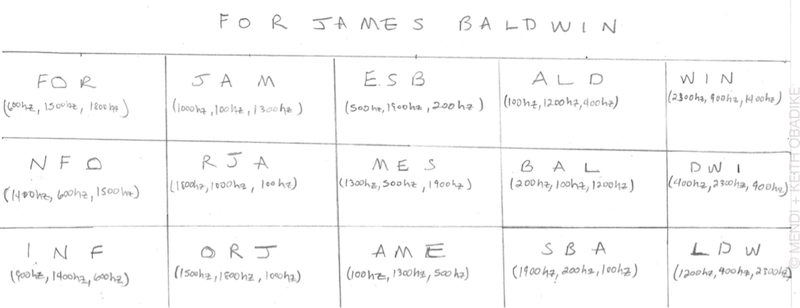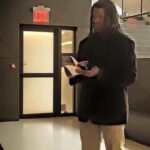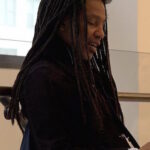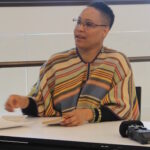In January 2016, I had the opportunity to dialogue over email with sound artists Mendi and Keith Obadike. We discussed their site-specific work, Blues Speaker [for James Baldwin](2015), jointly commissioned by the Harlem Stage and the Vera List Center for Art and Politics for installation in the New School’s University Center in New York City. The piece revolves around James Baldwin’s “Sonny’s Blues” (1948), which tells the story of a schoolteacher’s fraught relationship to his brother, a jazz pianist. The story is also a powerful social document of a family and its community in Harlem. As rendered by Baldwin, the social landscape is defined not only by music, but also by a wider field of sound, its subtle locations and dislocations in place and memory. In this interview, the Obadikes and I discuss their process making the installation and their thoughts on Baldwin, as well as their artistic relationship to sound and sonification more broadly.
Julie Beth Napolin (JBN): “Sonny’s Blues” takes on several modes of listening to location, some of them distant and in memory, and others highly in and of the present, transformative in being partner to what the narrator calls, in the final phrase of the story, “the very cup of trembling.” At the beginning of the story, Baldwin is careful to highlight alternating modes of listening in the formation of social memory. Though he has heard the sound of young boys at his window laughing many times, he says “their laughter struck me for perhaps the first time,” which also elevates this sound in his memory and capacity for recognition. He now hears his estranged brother, but also himself in that sound. In another but now expanded acoustic mirror, the story ends with an epiphany in relation to Sonny’s music, which the narrator had at one time failed to understand. He remarks of music “that not many people ever really hear it,” as if to suggest that there are layers, not acoustical, but structural, to hearing and the recognition it affords. He also tells us that most people, if they hear at all, only hear private and “vanishing evocations.”
I found Blues Speaker [for James Baldwin] to be a responsive continuation of Baldwin’s call for social memory through listening. What drew you to Baldwin and “Sonny’s Blues” as sources for a sound installation, and what does it mean to define your piece not only as an installation, but also as an “inventory” of the sounds of “Sonny’s Blues?” In this context, I’d like to know more about how you went about collecting and organizing sounds for the piece, and how that process, technologically and even politically, engages with Baldwin’s call to listening, memory, and recognition in what you also name a “praise song.”
Keith Obadike (KO): Harlem Stage and The Vera List Center for Art and Politics (at The New School) jointly approached us about making a piece. We’d worked with literature in many earlier works, so that might have encouraged them to invite us to consider making a work using Baldwin’s writings. What the commissioners didn’t know was that we had been thinking about sound in Baldwin’s writing for a couple of decades. Mendi actually wrote an essay about sound in “Sonny’s Blues” in the mid-nineties. So, we welcomed the opportunity to make a piece dealing with Baldwin’s work.
Mendi Obadike (MO): As we combed through the writing and lectures in James Baldwin’s body of work during our research phase of the project, we looked for the places where our methods and aesthetics met Baldwin’s. As Keith said, I had studied and written about “Sonny’s Blues” two decades prior. That early writing traced Baldwin’s ideas about the power of black music into his fiction (and the work of other black writers). “Sonny’s Blues” is full of moments where black musics (especially blues and gospel) carry other ideas about relationships and about states of being. In our recent readings of Baldwin’s work, we also found ourselves drawn to the way Baldwin writes about education as listening, as a practice of attending to the voices outside the walls of the schools. It was important to us to connect those ideas from his fiction and essays.
KO: So, why this form? Well, we’ve been making what we call praise songs, after the classical African mode, for a few years. We’ve made them for Marian Anderson, Marlon Riggs, Audre Lorde, Angela Davis, and Toni Morrison. Our praise songs deal with the ideas of artists (rather than the triumphs of the rulers) and have taken the shape of everything from pop songs to installations.
With Blues Speaker, we pulled from techniques developed across several areas of our practice to make this piece from our projects using architectural soundings to songwriting, field recordings, and vocal narrative projects. First the sounds: the source sounds came from vocals and tuned sine tones produced in the studio, a couple of original blues songs recorded in the studio, some thirty-year-old tape from our archive, and field recordings we made around Harlem. Next, we have the temporal element. The piece is twelve hours long, a nod to the twelve-bar blues. The piece ran from 9 a.m. to 9 p.m. each day. Inside of the twelve-hour cycle there were sound events that happened once a day, moments of silence, dynamic volume swells as well as long looping elements. Spatially the piece traced the diagonal glass facade using twenty-four channels of audio on three sides of the New School’s University Center. The idea was for the sound to wrap the building and emanate from the glass. The sounds chosen for each side of the building depended on how the space was used. For example, the glass wall on the west side of the building was next to a busy stairwell, but it was not next to a seating area like our other zones. This meant listeners would be passing through the area quickly, so we could occasionally do more pithy song-like gestures and low frequency material. In the zones where people sat and lounged we needed to do slower atmospheric moves with brief pauses and soft punctuations.
MO: It was also important to us to further activate the listening space by hosting events at the site of the installation. We invited three musicians who engage the blues to read the story “Sonny’s Blues” with an audience. The musicians we invited—Melvin Gibbs, Brandon Ross, and Karma Mayet Johnson—read the story in radically different ways.
Gibbs stood (as he does when playing bass) and read the whole story from beginning to end. Ross sat and read from two versions of the text; he rearranged the order of the sections and read some of them more than once. Johnson sampled the text, choosing one passage from the beginning, one from near the end, and one about the color indigo (which she explained was one of her favorite words). All of these interactions taught us new things about how to hear the music in a person’s voice and the music in a space filled with people and their different relationships to the space. Our work taught us about the differences in the ways people who are lounging, people who are visiting, and people who are working in a space listen to it. And the different kinds of work people do in a space also shape the kinds of listening they do.
The creation of this work necessitates an awareness of how people use space, what they need it to do, what sounds they add to the soundscape, and how they need to listen to do what they’ve come to do. These are things that are easy to miss unless one’s everyday activities include a habit of engaged listening. Like Baldwin, we believe that an engaged populace must practice paying attention to the ways we all move through space.
JBN: I sensed that experiential dimension in the rhythm between institutional ways of inhabiting space and the forms of listening and moving invited by Blues Speaker. It was no less pedagogical in taking me through a particular reading of text, but also of a space, its possibilities and its boundaries—a call to a state of being, as Mendi says. The building itself was resonant, or what you’ve called a “speaker.” The piece also involves Mendi’s recorded reading of portions of Baldwin texts. It is uncanny to hear such an intimate or subtle voice within the broadcast dimensions of institutional space—not the typical disembodied voice of announcement systems. Mendi’s inflection recalls jazz and blues timbre and poetics. It also draws in the listener’s attention but doesn’t demand that he or she listen in an informational way. A blues speaker/speaker of the blues.
MO: One important thing about the voice in the piece for me is that I don’t think of the vocal inflection in the piece as mine, but rather ours. Because we record it together, because I am tuning to the tones Keith produces, because sometimes Keith alters the way my voice sounds in the recording, what the listener hears in my voice are choices that are made by both of us. So, it’s our voice. That it feels intimate is a result of my intention in the speaking of the words, also of some alterations by Keith, but I think that it is also to a great degree a result of our turning towards one another in the process of making the work.
MO: A lot of our work is about translating an idea from one context to a very different context. We think we all understand what the blues is, but what if instead of using twelve bars we see its form develop over twelve hours? What if instead of moving sound between two channels we move it across twenty-four and from one side of the building to another? It sounds different. It even feels different, but can it give you the opportunity to hold some of the same information in a different way, too? Of course, we mean for the title to point in many directions, and idea of speaking the blues is certainly one of them. But I think that even when the blues is being communicated through sound, it is as a kind of knowledge, a way of processing the sorrowful news and coming out on the other side with information about survival. It isn’t a trope of a genre. It is a feeling. It is also a way of dealing with feeling, of thinking through and about feeling, of doing so in community with others who also know what to do with it.
JBN: In thinking about this voice and feeling in conjunction with the many references suggested by your title, I’m reminded of another source-work for your piece, Baldwin’s “The Uses of the Blues” where he begins by saying that his title “does not refer to music.” He goes on to say, “it does refer to the experience of life, the state of being, out of which the blues come.” Baldwin also says in this essay that he doesn’t know what race is except a “social fact.” Were these two texts, fiction and essay, working together for you in what your piece circles around—or acoustically incants—as blues? What did the blues mean for you in engaging an institutional space and its acoustical boundaries, which are invisibly shaped by the social fact that is race?
KO: We did reread Baldwin’s “The Uses of the Blues” during our research period, but we actually pulled quotes from other Baldwin texts. We used quotes from “A Talk to Teachers” and a quote from “Sermons and Blues.” And of course, we used several quotations from “Sonny’s Blues.”
I could go on for some time about what the blues means to me, but I will try to be succinct. I grew up playing guitar in Nashville, Tennessee in a place and time where the formal elements of the popular music had changed since the peak of blues record sales, but the feeling (and some practices) of blues music still permeated everything. I had one relative deeply involved in church music and another in the blues. So, in many ways it is a foundational thing that has carried me through studies in art and design to the kinds of work we make today.
We hope one of our contributions to the music through this mix of blues and sound art might be exploring the spatial and architectural possibilities of the blues. Our site for the Blues Speaker installation, The New School’s University Center, has large glass panels tracing the walkways on all sides of the building. The glass is not just a functional portal, but also a design choice with social implications. We know that glass often represents a kind of utopian gesture in architecture. Some of these ideas came from Paul Scheerbart’s Glass Architecture (1914). As we studied people moving throughout the building while looking down on a pulsing Manhattan, we wanted to vibrate those portals. We wanted to think about what the blues had to say to this structure; Baldwin gave us the lyrics.
JBN: Baldwin’s chosen medium was not music, or even poetry, which we more immediately associate with sound, but prose. To go back to your process, Blues Speaker is a relay between prose and sound, between imaginary or textual sounds and signal—from reading, writing, remembering, gathering, and generating sounds to staging them amongst the text, read aloud, and thus now a sound amongst sounds. I’m tempted to say here that prose, its value and its form for Baldwin, is sonified by Blues Speaker. The generated sine tones in conjunction with words suggested that writing itself is sonorously inaudible.
MO: Listeners sometimes respond to language differently than they do to field recordings, but for us the speech is part of the whole field of sound. All of it can be read, internalized, ignored, danced to.
JBN: I think there is continuity there with your recent piece, Numbers Station [Furtive Movements], the first of a new series where you move away from words to pair sine tones and numbers as drawn from Stop and Frisk data, lynching statistics, and slave ship manifests.
JBN: The information becomes “nonsense,” as it were. There is no narrative, no story, only numbers and sounds. As an installation, Furtive Movements is haunting in that we see old communications technology in the room, two broadcast stations facing each other, which ostensibly communicate these acoustic ecologies invisibly in the airwaves. It drew to my attention the way information catalogues yet disavows the subordination of racialized bodies. This information is constantly transmitted beneath or outside of my capacity for audition yet is materially part of my hearing space. How did you move from something like Blues Speaker to Furtive Movements, and where does sound go from here?
MO: First: we are always working on more than one thing at a time. We actually began thinking on the idea for the Furtive Movements sound piece before the opportunity to make Blues Speaker came about. That said, for us the narrative is in the numbers. The more you spend time with them, the more you begin to feel or imagine the spaces and people they represent, you begin to have a sense for the areas with high policing and what it means when the numbers of stops changes radically. There most certainly is a story there. But it is hard to get close enough to the numbers to feel them. Paring the text down to the numbers helps us get close to them, but we also lose ourselves in them, our minds also drift. The difficulty of staying with a way of listening, of attending to the data, is part of the work.
KO: We should also say that we’ve used sine tones across these two very different series of projects, one being our praise songs like Blues Speaker and two being our numbers pieces like Numbers Station [Furtive Movements], Numbers Station [Red Records], and Numbers Station [Manifests]. In the praise songs the tones are used to “say” the name of the dedicatee in a nonverbal way. And then the sine tones are sometimes doubled with vocals. In our system, which we call alpha-sonics, we assign a frequency to each letter of the alphabet. For example, the letter A would have a 100hz tone and B a 200hz tone and so on. We spell the subject’s name and a dedication with the tones and then often group the tones into triads. Essentially this process will give us a bank of sounds or a chordal vocabulary for each piece. For example, we start with the dedication and make a series of largely triadic inversions or permutations on letters and frequencies.

For the series of numbers works we wanted to deal with the incredible trauma and loss represented in these records, loss related to American violence against African bodies. We studied funeral chants and sonic laments from around the world. We recently made a numbers work, Numbers Station [Red Records], based on data in Ida B. Wells’s 1895 book The Red Record: Tabulated Statistics and Alleged Causes of Lynching in the United States. [The Obadikes performed this work on March 2017 in a concert series organized by pianist Vijay Iyer at The Metropolitan Museum of Art].
In the piece Numbers Station [Furtive Movements] we collected NYPD Stop and Frisk data and sonified it. In September 2015, we performed live and did a radio broadcast of Furtive Movements at Ryan Lee Gallery in New York. Each police precinct in New York City reported a number of stops for each quarter of each year. We use the numbers of stops and precinct numbers to generate our tones. The tones were mixed and processed in a dub-like fashion. This was the starting place for what eventually became the underscoring for our vocal performance of the numbers in the gallery. We are sonifying these numbers to allow people to meditate on data that might otherwise be hard to hold.





